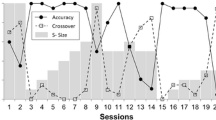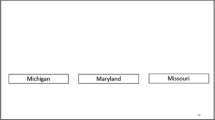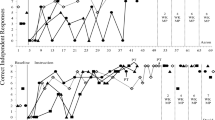Abstract
This study was designed to assess the effectiveness of using prompts (extra “guiding” stimuli) for teaching normal and autistic children. One group of normal children was pretrained on a color discrimination. Later, the colors were used as prompts (presented simultaneously with new training stimuli) to teach four new discriminations. Another group of normal children was trained on the same discriminations with a trial-and-error procedure (i.e., no prompting). A third group consisted of autistic children who were trained on these discriminations using the prompt procedure. Analyses of the results showed the following. (1) The trial-and-error group of normal children acquired more discriminations than the prompt group of normal children. (2) A comparison of the two prompt groups showed that the autistics failed to transfer from the prompt cue to the training cue more often than the normal children; rather, the autistics generally continued responding to the faded color cue. (3) Autistic and normal children who failed to acquire the discriminations when trained with a prompt procedure did acquire these discriminations when no prompt was used. That is, the results suggest that the presentation of an extra guiding stimulus was detrimental to the acquisition of training discriminations for all subjects, and particularly so for autistic children. Therefore, the common practice of providing extra guiding stimuli in proportion to the severity of the learning disorder may actually be harmfid to the learning of new skills. Implications of these results for future research are discussed.
Similar content being viewed by others
References
Fellows, B. J.The discrimination process and development. London: Pergamon Press, 1968.
Gellerman, L. W. Chance orders of alternating stimuli in visual discrimination experiments.Journal of Genetic Psychology, 1933,42, 206–208.
Hermelin, B. Recent psychological research. In J. K. Wing (Ed.),Early childhood autism. London: Pergamon Press, 1966.
Koegel, R. L. & Wilhelm, H. Selective responding to components of multiple visual stimuli by autistic children.Journal of Experimental Child Psychology, 1973,15, 442–453.
Koegel, R. L., & Rincover, A. Treatment of psychotic children in a classroom environment: I. Learning in a large group.Journal of Applied Behavior Analysis, 1974,7, 45–59.
Lovaas, O. I., Berberich, J. P., Perloff, B. F., & Schaeffer, B. Acquisition of imitative speech in schizophrenic children.Science, 1966,151, 705–707.
Lovaas, O. I., Freitas, L., Nelson, K., & Whalen, C. Building social and preschool behaviors in schizophrenic and autistic children through nonverbal imitation training.Behaviour Research and Therapy, 1967,5, 171–181.
Lovaas, O. I. & Schreibman, L. Stimulus overselectivity of autistic children in a two stimulus situation.Behaviour Research and Therapy, 1971,9, 305–310.
Lovaas, O. I., Schreibman, L., Koegel, R., & Rehm, R. Selective responding by autistic children to multiple sensory input.Journal of Abnormal Psychology, 1971,77, 211–222.
Metz, J. P. Conditioning generalized imitation in autistic children.Journal of Experimental Child Psychology, 1965,2, 389–399.
Rimland, B.Infantile autism. New York: Appleton-Century-Crofts, 1964.
Rincover, A., & Koegel, R. L. Setting generality and stimulus control in autistic children.Journal of Applied Behavior Analysis, 1975,8, 235–246.
Risley, T. R., & Wolf, M. M. Establishing functional speech in echolalic children.Behaviour Research and Therapy, 1967,5, 73–78.
Schreibman, L. Effects of within-stimulus and extra-stimulus prompting on discrimination learning in autistic children.Journal of Applied Behavior Analysis, 1975,8, 91–112.
Schreibman, L., & Lovaas, O. I. Overselective responding to social stimuli by autistic children.Journal of Abnormal Child Psychology, 1973,1, 152–168.
Sutherland, N. S., & MacKintosh, N. J.Mechanisms of animal discrimination learning. New York: Academic Press. 1971.
Trabasso, T., & Bower, G. H.Attention in learning. New York: Wiley, 1968.
Author information
Authors and Affiliations
Additional information
The research was supported by the United States Public Health Service Research Grant 11440 from the National Institute of Mental Health. Manuscript preparation was also supported in part by State of California Research Grant #42-00000-0000832/025, Title VI-B of the United States Elementary and Secondary Education Act. The authors are grateful to Prof. Ivar Lovaas, for his many contributions to this work. Many persons have helped in this research; in particular the authors are grateful to Laura Schreibman and George Rekers for their helpful comments. The research was carried out with the help of Madeline Hunter of the UCLA University Elementary School, and Norbert Rieger and Barbara Bishop of the Children's Treatment Center, Camarillo State Hospital, Camarillo, California.
Rights and permissions
About this article
Cite this article
Koegel, R.L., Rincover, A. Some detrimental effects of using extra stimuli to guide learning in normal and autistic children. J Abnorm Child Psychol 4, 59–71 (1976). https://doi.org/10.1007/BF00917605
Revised:
Issue Date:
DOI: https://doi.org/10.1007/BF00917605




